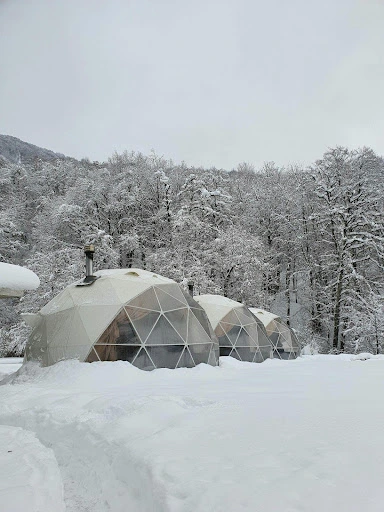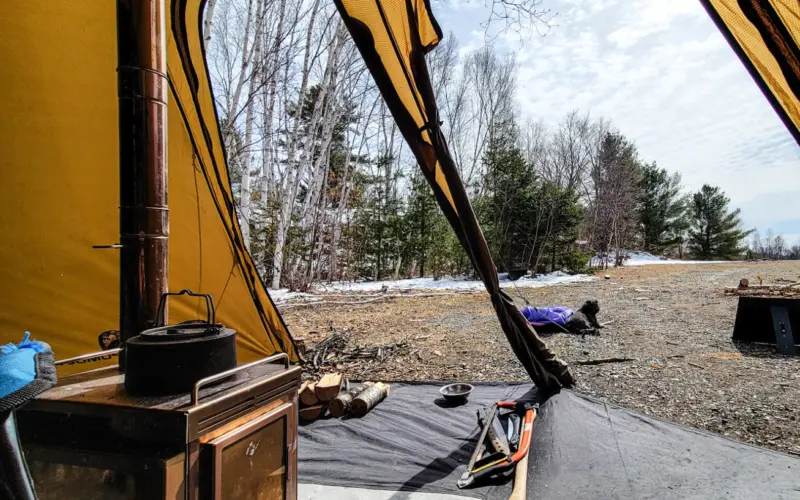For outdoor enthusiasts, a reliable and efficient portable camping woodstove is more than just a tool; it’s the heart of the campsite, providing warmth, light, and a means to cook meals away from the cold.
Selecting the right woodstove can make or break a camping trip, making it critical to know what to look for. This article will guide you through essential considerations such as heat output, portability, and durability so that you purchase and pack the right woodstove for your camping adventure needs.

Table of Contents
Portability and Size
When considering a portable camping woodstove, its portability, and size are attributes that can significantly impact things like wood burning time and weight. A compact design is great for easy transport, particularly if you intend to move your campsite frequently or venture into remote areas.
Lightweight stoves are preferred for backpacking, where every ounce matters, while heavier, more durable options might be suitable for car camping where weight constraints are less of a concern.
The size of the woodstove should align with the size of the tent you aim to heat, ensuring efficient warming without overcrowding the space. For example, you wouldn’t use a small titanium woodstove meant for above-freezing to help heat your massive yurt.
Some stoves offer folding features that enhance space efficiency, making them more convenient to pack. The chimney pipe often comes in segments or requires rolling and securing with rings.
Although both designs are effective, it’s important to note that roll-up pipes can become dented more easily and might be challenging to set up at first. However, once heated, they generally maintain their shape well, forming a reliable chimney for smoke exhaust.

Heating Capacity and Cooking Performance
The heating capacity of a portable camping woodstove is another important factor, especially for those chilly nights below freezing. You want a big enough firebox that you can fill with enough wood that you can get a decent sleep at night.
The firebox size, usually measured in liters, indicates the stove’s fuel capacity. A size of 25-30 liters is deemed ideal for a large tent, as anything smaller may struggle to meet the heating requirements during colder nights. Heat output, denoted in BTUs (British Thermal Units), is another essential aspect to consider for effective warming of your camping space, but that mostly focuses on the wood type you are using.
For cooking purposes, the size of the cooking area matters depending on the group size and the need for even heat distribution for meal preparation. A stove with a multi-functional design enhances the camping experience by enabling different cooking methods such as boiling, grilling, and simmering.
Some stoves are equipped with boiling tanks on the side, offering a convenient solution for hot drinks, while others feature a removable top, providing additional heat for cooking. These are just nice quality-of-life features that ensure that mealtime at the campsite is as comfortable and enjoyable as possible.
Material Quality and Durability
The longevity and performance of a portable camping woodstove are significantly influenced by the quality of materials used in its construction. High-grade stainless steel and titanium are among the most popular choices due to their robustness (they don’t rust easily) and ability to withstand harsh outdoor conditions.
Stainless steel stoves, known for their thick walls, are excellent for retaining heat for extended periods, making them ideal for heating purposes. This means the material is great for use in really cold temperatures.
On the other hand, titanium stoves feature thinner walls that heat up and cool down rapidly, which is advantageous for cooking but may not hold heat as long as stainless steel. This can also sometimes lead to warping of the metal itself. Some titanium stoves only weigh a couple of pounds and fold up which means you can take them far into the backcountry with you.
The good news is that all of these materials allow for easy maintenance and cleaning, a crucial factor for equipment frequently exposed to the outdoors and intense heat. Whether you prioritize cooking efficiency or long-lasting warmth, selecting a stove made from high-quality materials is essential for a satisfactory camping experience.

Safety Features
Ensuring safety while enjoying the warmth and utility of a portable camping wood stove is not only important to keep your gear intact, but also to keep you alive. One fundamental feature that is often harder to find than you’d think is a stable base and support system. The stove must stand firm even on uneven ground to prevent accidental tipping.
If your wood stove is angled forward, for example, hot coals can sometimes roll out when you open the door. Speaking of doors, heat-resistant door handles, vent sliders, and a damper are important too, allowing for heat adjustments without the risk of burns.
Proper ventilation is also critical to prevent the buildup of carbon monoxide inside tents or enclosed spaces. Try to find a stove with no gaps between the stove and chimney pipe to ensure a strong draft.
Another safety feature I look for is the spark arrestor for the top of your pipe. You’ll need this in the warmer months (or with really dry wood) to prevent embers or sparks from escaping the chimney and potentially causing holes or fires in your tent fabric.
Ease of Use and Setup
Ease of use and setup is crucial for any camping wood stove, making your outdoor adventures as enjoyable as possible. An intuitive assembly and disassembly process ensures that you can quickly set up or pack away your stove with minimal fuss.
User-friendly controls for temperature adjustment are essential for cooking precision and comfort management. Additionally, multiple vents for airflow control allow for efficient fuel use and temperature regulation.
Glass windows can add a charming touch, letting you monitor the fire without opening the door, though they might require installation and occasional maintenance, such as gasket replacement, to ensure it has the best possible airflow.

Budget Considerations
Balancing cost with features and quality is essential when selecting a portable camping woodstove. Often, the most expensive materials, like high-grade stainless steel, offer durability and resistance to corrosion, which justifies their price. Before purchasing, consider what you will be using the stove for; whether it’s for occasional camping or more intensive, regular use.
Compare the value for money across different price ranges, as sometimes a higher initial investment in a stove can mean better long-term savings due to its longevity and efficiency.
Weighing the benefits of a long-term investment against budget-friendly options is good for your pocket and peace of mind. It will all come down to your specific needs and how often you plan to use the stove.

Final Thoughts
Choosing the ideal camping wood stove hinges on understanding the balance between ease of use, budget considerations, and personal needs. Essential elements like user-friendly design, efficient temperature control, and durability against the elements play a pivotal role.
Weigh these factors against your camping frequency and what you value most in an outdoor cooking experience. A last piece of advice is if you are in doubt of whether the stove will keep you warm or not then go for the bigger size, just to be safe.









